Understanding What Morticians Do to Prepare the Deceased
When someone passes away, what does a mortician do to the body involves several careful processes designed to preserve dignity and prepare for final arrangements. Here's a quick overview of the essential steps:
| Step | What Happens |
|---|---|
| 1. Retrieval | The body is transported from place of death to funeral home |
| 2. Sanitization | Body is washed with disinfectant and prepared for preservation |
| 3. Preservation | Embalming or refrigeration depending on family wishes |
| 4. Restoration | Facial features are set, cosmetics applied, hair styled |
| 5. Dressing | Body is clothed according to family preferences |
| 6. Casketing | Final placement in casket or container for services |
The death of a loved one is both heartbreaking and difficult to process. Behind the scenes, morticians work with compassion and precision to ensure the deceased is treated with respect while being prepared for their final farewell.
I'm Mortuary Cooler, a national-level mortuary cooler supplier with experience in the funeral industry. Having worked closely with morticians for years, I've gained intimate knowledge of what does a mortician do to the body and the essential equipment needed to maintain dignity throughout the process.
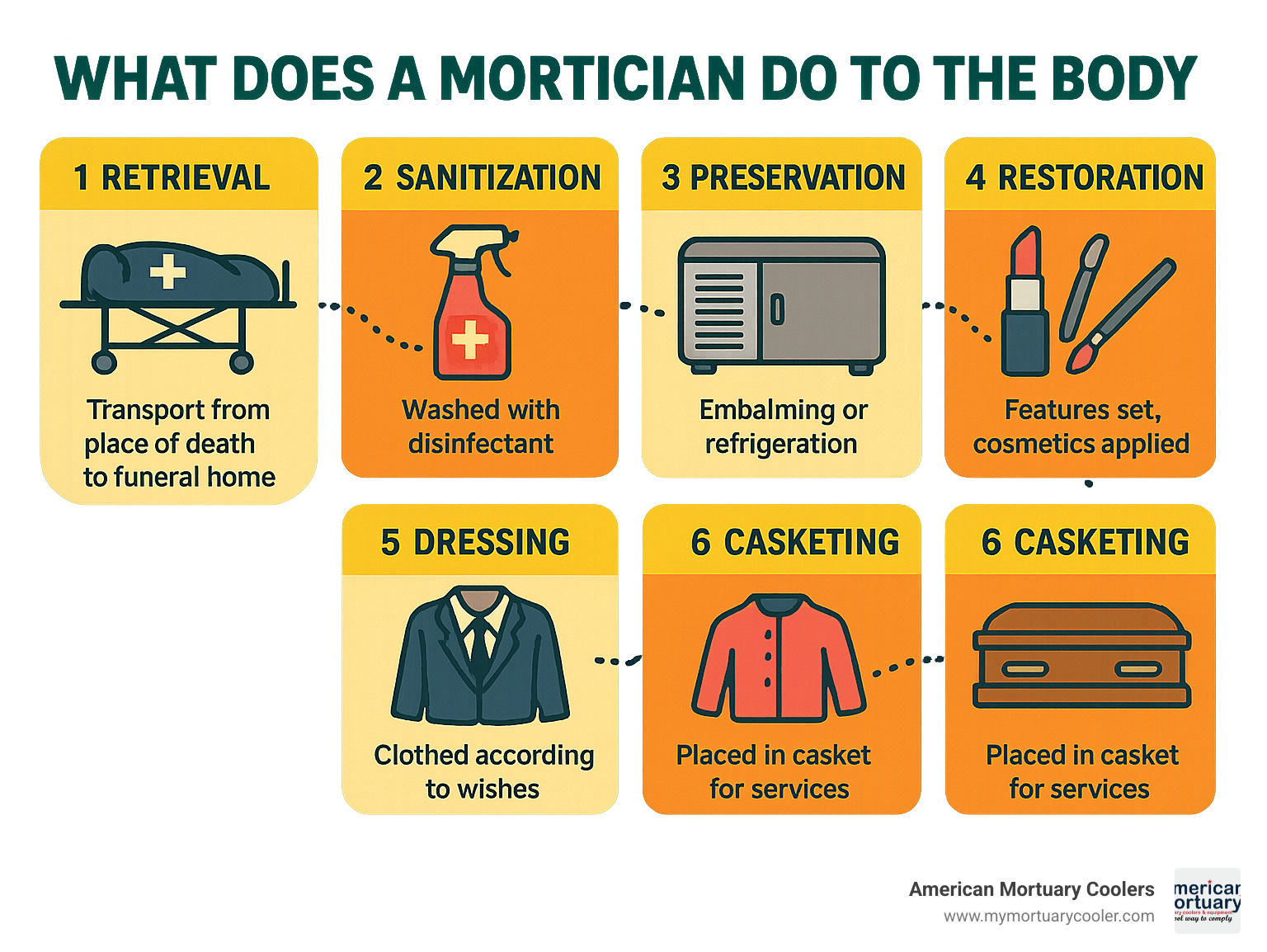
Why This Guide Matters
Understanding what does a mortician do to the body matters for several important reasons:
For families, knowledge demystifies the process during an emotionally challenging time. When you understand what happens after you entrust your loved one to a funeral home, it can provide comfort and reduce anxiety about the unknown.
For students considering mortuary science as a career, this guide offers insight into the daily responsibilities and technical skills required in this compassionate profession.
For healthcare workers and first responders who interact with morticians, understanding the complete process helps create a smoother transition of care for the deceased.
What Does a Mortician Do to the Body: Overview of Responsibilities
When we think about funeral care, the role of a mortician extends far beyond what most people imagine. These compassionate professionals—sometimes called funeral directors or undertakers—serve as both caretakers for the deceased and guides for the living during life's most difficult moments.
What does a mortician do to the body begins with answering the call of duty, often at unpredictable hours. Morticians typically remain on-call around the clock because death rarely adheres to a convenient schedule. When a family reaches out, these professionals coordinate the transportation of their loved one from wherever death occurred to the funeral home's care center.
Once the deceased arrives, the mortician handles essential paperwork including death certificates and burial permits. But perhaps their most valuable service is as compassionate counselors, guiding families through difficult decisions with warmth and understanding.
According to the Bureau of Labor Statistics, these dedicated professionals earn around $59,000 annually nationwide, though geography plays a significant role in compensation. In Connecticut, for instance, morticians can expect considerably higher earnings—approximately $159,970 yearly.
Looking ahead, the funeral profession appears stable and growing. Census Bureau research indicates that as baby boomers age, the annual death rate will increase steadily, creating ongoing demand for these essential services.
Key Phases in What Does a Mortician Do to the Body
The journey of caring for the deceased follows a thoughtful, dignified path that unfolds in several distinct phases:
When the phone rings with that first call, the mortician gathers essential information and arranges for transportation. Upon arrival at the funeral home, if embalming isn't immediate, the body is placed in refrigeration within a mortuary cooler to preserve it naturally.
For families choosing traditional services, embalming provides temporary preservation through careful chemical treatment. Following preservation, the art of restorative techniques begins—a blend of science and artistry that helps present the deceased in a way that brings comfort to grieving families.
Skills Needed to Perform What Does a Mortician Do to the Body
Behind every compassionate funeral service stands a professional with a diverse skillset. Successful morticians blend technical expertise with genuine human connection.
Deep anatomical knowledge forms the foundation of their work, allowing them to perform preservation techniques properly. This pairs with chemical expertise for safely handling and applying embalming solutions. But technical skills alone aren't enough—the heart of this profession lies in grief communication, the ability to speak gently with bereaved families during their most vulnerable moments.
Morticians also need solid business management abilities and event planning skills to coordinate meaningful services.
Most states maintain high professional standards, requiring morticians to complete specific education and licensing requirements, including an associate degree in mortuary science, national board examinations, an apprenticeship, and state licensure.
From First Call to Prep Room: Initial Handling & Sanitation
When someone passes away, the journey of what does a mortician do to the body begins with what funeral professionals call the "first call." This is that solemn moment when a mortician receives notification that someone has died and needs to be brought into their care.
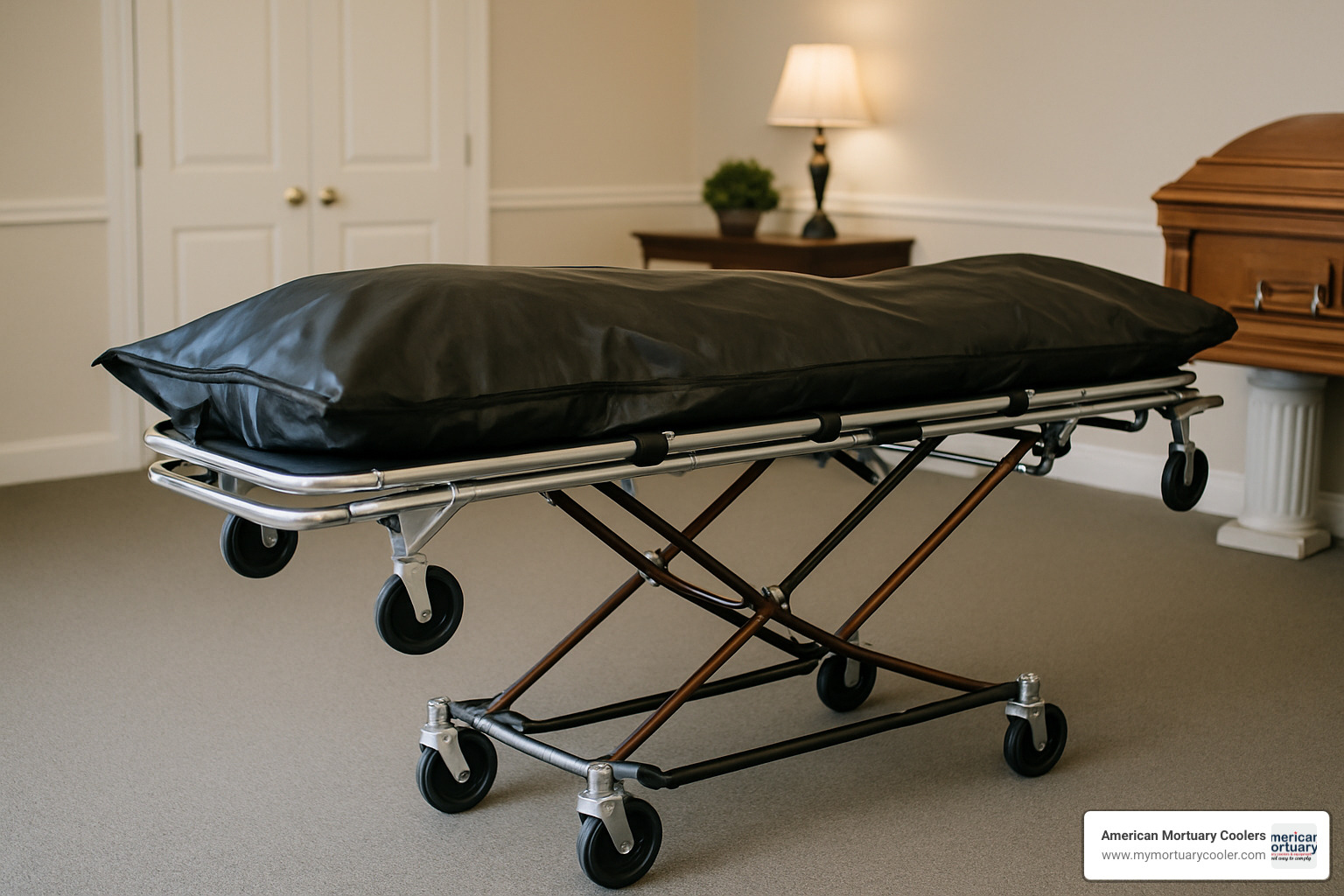
Upon arrival at the funeral home, the mortician's first task is proper identification. This isn't just procedural—it's a sacred responsibility to ensure the right person receives the care their family has arranged.
Next comes a thorough inventory of personal belongings. Wedding rings, necklaces, watches, and other sentimental items are carefully documented. Some items will be returned to the family, while others might stay with their loved one per their wishes.
If embalming won't happen right away, the body is gently placed in a mortuary cooler. These specialized refrigeration units maintain a consistent temperature around 38°F (3.3°C) to slow natural changes after death.
At American Mortuary Coolers, we've spent years creating cooling solutions specifically designed for funeral homes across America.
Arrival Protocols & Equipment
The initial handling phase requires specialized equipment that most people never see. Body bags provide dignified, sanitary transportation. Removal cots—special stretchers designed specifically for this purpose—allow for respectful movement of the deceased. Morticians always wear appropriate protective equipment including gloves, gowns, and sometimes masks and eye protection.
Throughout transportation, morticians follow strict chain of custody procedures with detailed documentation.
Once in the preparation room, the gentle process of sanitation begins. The body is carefully washed with specialized disinfectant solutions. If the person had any wounds or medical devices, these receive particular attention.
When rigor mortis has set in (the natural stiffening of muscles after death), the mortician will work slowly and respectfully to relieve this stiffness through gentle massage.
For funeral homes looking to update their facilities with modern equipment, our Essential Embalming Equipment guide offers insights into the latest technologies.
Legal & Health Safeguards
The preparation room in a funeral home is designed to mirror hospital operating rooms, with strict sanitation standards and bright lighting. Here, morticians follow OSHA guidelines and universal precautions.
One vital safety check involves examining for pacemakers or other implanted medical devices. This isn't just procedural—pacemakers must be removed before cremation because they can explode when exposed to high temperatures.
Beyond the physical care, morticians handle important paperwork including death certificates and permits for burial, cremation, or transportation across state lines.
Throughout these initial procedures, morticians maintain a delicate balance between technical precision and heartfelt respect, honoring the life lived and the people who loved them.
The Embalming Process Step by Step
Embalming is perhaps the most technical aspect of what does a mortician do to the body. While not required by law in most cases, this preservation method remains common practice in the United States and Canada, especially when families plan a viewing or when there's a delay between death and final arrangements.
The art of preserving human remains dates back to ancient Egypt around 6000 B.C. Modern embalming gained popularity during the American Civil War, when families wanted their fallen soldiers preserved for the journey home for burial.
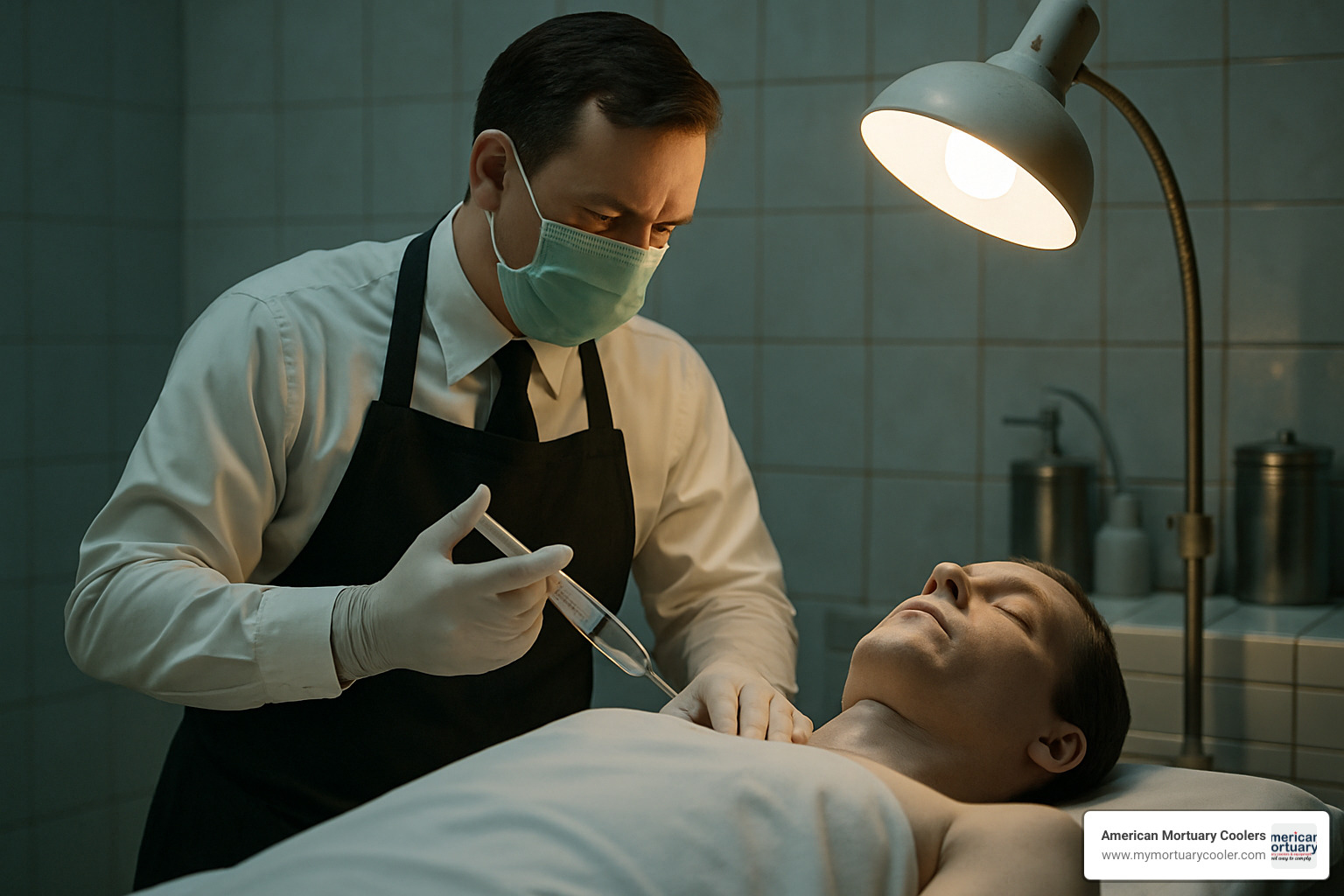
Today's embalming blends scientific precision with artistic restoration. A typical procedure takes between 1-3 hours and uses about 3 gallons of specialized fluid mixture.
There are two main approaches to embalming, each serving different preservation needs:
| Type | Purpose | Method | Chemicals Used |
|---|---|---|---|
| Arterial Embalming | Preserves tissues throughout the body | Injection into arterial system | Formaldehyde, glutaraldehyde, methanol, ethanol, phenol, water, dyes |
| Cavity Embalming | Preserves internal organs | Direct injection into body cavities | Stronger concentration of formaldehyde-based fluid |
For those wanting to understand more about these processes, our Guide to the Embalming Process offers a more detailed explanation.
Surgical Embalming Procedures
The surgical aspects of embalming follow a careful sequence. The mortician positions the body on a specialized embalming table with built-in drainage and dons full protective equipment.
Next comes selecting an injection site, typically the carotid artery in the neck or the femoral artery in the groin. The mortician makes a small incision to access the selected artery and inserts a cannula (a thin tube) for fluid injection.
A corresponding drainage tube goes into a nearby vein, allowing blood to exit as the embalming fluid enters. Using equipment like the Porti-Boy embalming machine, the mortician introduces a formaldehyde-based solution into the arterial system.
After completing the arterial process, the mortician addresses the body's internal organs through cavity embalming. Using a trocar (a specialized hollow needle), they puncture the abdominal and thoracic cavities to remove gases and fluids from internal organs, then deliver a stronger concentration of preservative directly to these areas.
Finally, all incisions are carefully sutured closed, and the trocar puncture site receives a plastic "trocar button" seal to prevent leakage.
Cosmetic & Presentation Work
After preservation comes the truly artistic phase – the restorative and cosmetic work that helps families see their loved one at peace.
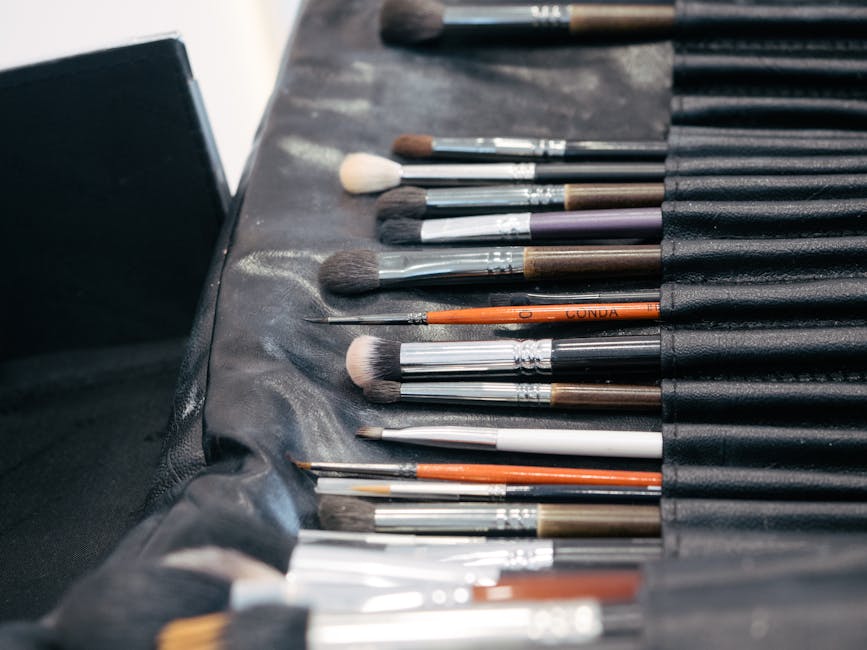
Setting the facial features requires both technical skill and aesthetic sensitivity. For the eyes, the mortician places specialized plastic eye caps under the eyelids to keep them naturally closed. The mouth is positioned in a relaxed expression, typically by carefully wiring or suturing the jaw. Cotton in the cheeks helps create natural facial contours.
Restorative work addresses any areas needing special attention, including wax reconstruction for damaged areas or specialized treatments for discolorations.
The cosmetic phase is where artistry truly shines. Mortuary cosmetics differ significantly from everyday makeup – they're specially formulated to adhere to preserved skin and create a natural appearance. Many modern morticians use airbrush systems for the most subtle, lifelike results.
Hair preparation involves washing, drying, and styling according to family photos or the deceased's usual appearance.
The final touch is dressing the deceased in clothing provided by the family, using special techniques to ensure a natural appearance.
Post-Embalming Care & Casketing
The final phase focuses on preparing the deceased for placement in their casket. This begins with a thorough final inspection, checking for any leakage from incision sites or natural openings.
A comprehensive quality check ensures the preservation is complete and the appearance meets professional standards. Only then does casketing begin – the careful placement of the body in the selected casket. The positioning is crucial: the head rests gently on a small pillow, hands are arranged, and the body is positioned slightly to one side for a natural, restful appearance.
Throughout this entire process, morticians maintain meticulous attention to detail, knowing their work creates the final memory families will carry of their loved ones.
Alternatives, Special Cases & Modern Trends
While embalming has long been the traditional approach in American funeral practices, there's a growing interest in alternatives when it comes to what does a mortician do to the body. These options are gaining popularity as families consider environmental impact, honor religious traditions, or respect their loved one's personal wishes.
Refrigeration
When families choose not to embalm, refrigeration becomes the primary preservation method. Modern mortuary coolers maintain bodies at temperatures that significantly slow the natural processes that occur after death.
This approach is environmentally friendly with no chemicals involved, more affordable than traditional embalming, and legally required in many states when embalming isn't performed.
Dry Ice
Some funeral homes, particularly those supporting home funerals, use dry ice as a temporary preservation method. This solid form of carbon dioxide is strategically placed around the body to maintain low temperatures without mechanical refrigeration. It's particularly useful for home wakes and green burial preparations.
Green Burial
The growing green burial movement emphasizes minimal intervention and natural return to the earth. In these cases, what does a mortician do to the body involves a gentler approach:
The body receives a respectful washing and natural disinfection, but no preservation chemicals are used. The deceased is dressed in biodegradable clothing made from natural fibers, or wrapped in a simple natural fiber shroud. Rather than hardwood or metal caskets, green burials use biodegradable containers that will naturally decompose.
Alkaline Hydrolysis
Also known as aquamation or water cremation, alkaline hydrolysis represents one of the newest options in the funeral industry. This process uses water, alkaline chemicals, heat, and pressure to accelerate natural decomposition, leaving behind bone fragments similar to traditional cremation.
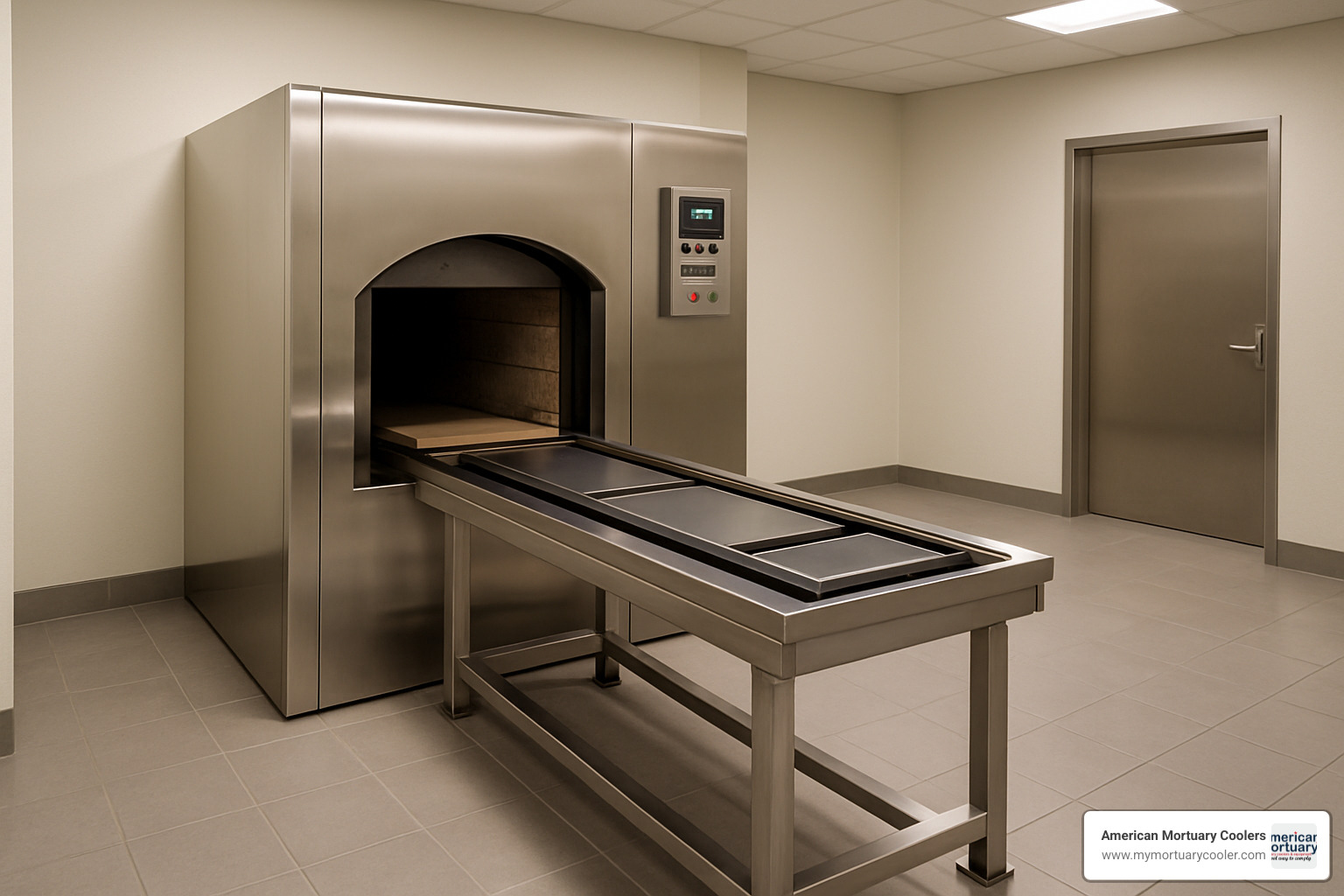
Special Cases
Morticians must adapt their techniques for special circumstances that require additional care and expertise:
When working with autopsy cases, morticians face unique challenges. The mortician must carefully suture autopsy incisions, use specialized techniques to restore the body's appearance, and apply additional preservation methods to affected areas.
For organ donors, morticians work closely with procurement organizations. These cases often require additional reconstruction, specialized embalming approaches, and creative cosmetic work to respectfully hide incisions while honoring the person's life-saving gift.
Preparing Bodies for Cremation vs Burial
What does a mortician do to the body varies significantly depending on whether cremation or burial is the family's choice.
For cremation preparation, identification is paramount. Morticians place ID tags that survive the cremation process with the body. They carefully remove pacemakers and certain medical implants that could be dangerous during cremation. If no viewing is planned, preparation is minimal.
For burial preparation, the process is typically more extensive. It may include full embalming (if chosen), complete cosmetic preparation, dressing in burial clothing selected by the family, and careful placement in the chosen casket.
Respecting Religion & Culture
Different faiths and cultures have specific requirements for what does a mortician do to the body. Professional morticians take pride in accommodating these needs with respect and attention to detail.
In Islamic traditions, the ritual washing called Ghusl is performed by Muslims of the same gender as the deceased. The body is wrapped in simple white shrouds (kafan), and embalming is generally avoided unless required by law.
Jewish traditions include a ritual washing called Tahara, performed by the Chevra Kadisha (burial society). Embalming is generally not performed, and the deceased is placed in a simple wooden casket, with burial arranged as soon as possible.
For those who served our country, military honors require special attention to uniform preparation, flag folding protocols, and coordination with military personnel for ceremonial honors.
Compliance, Education & Evolving Perceptions
Behind every dignified funeral service lies a professional who's met rigorous standards to perform what does a mortician do to the body. This isn't a career you can simply walk into—it requires dedication, education, and ongoing commitment to both technical excellence and compassionate care.
Each state maintains its own licensing board that oversees funeral professionals. The path to becoming a licensed mortician typically involves earning an associate degree in mortuary science from an accredited program, passing the National Board Examination, completing a 1-2 year apprenticeship, and finally passing state-specific licensing exams.
This education covers anatomy, chemistry, embalming techniques, restorative art, grief counseling, business management, and funeral law—a blend of technical knowledge and people skills.
The chemicals used in embalming, particularly formaldehyde, fall under strict OSHA regulations. Modern prep rooms feature proper ventilation systems, and morticians use personal protective equipment to safeguard their health.
One of the most remarkable developments in recent years has been in restorative art techniques. Today's morticians work with specialized waxes, fillers, and cosmetics that can achieve incredible restoration even after traumatic injuries.
If you're curious about pursuing this career, our detailed guide on How to Learn Embalming: 5 Methods That Guarantee Results walks through the various pathways to enter the profession.
Training & Career Outlook
The Bureau of Labor Statistics projects steady demand for funeral professionals, largely due to our aging population.
What might surprise many is the salary potential. While the national average hovers around $59,000, location matters tremendously—morticians in Connecticut can earn nearly $160,000 annually.
Continuing education is required to maintain licensure, ensuring morticians stay current with evolving techniques, regulations, and best practices. Many professionals develop specialties within the field, whether that's mastering the art of restoration, becoming knowledgeable in green burial practices, specializing in cultural funeral traditions, or focusing on funeral home management.
What makes an exceptional mortician isn't just technical precision—though that's essential—but the rare combination of scientific knowledge and genuine compassion.
How the Profession Has Changed Over Time
The history of what does a mortician do to the body reads like a fascinating journey through human ritual, science, and social values.
In ancient Egypt, embalmers were highly respected specialists who preserved bodies through mummification. Modern American embalming practices gained widespread adoption during the Civil War, with soldiers dying far from home.
The early 20th century brought standardization to the industry. Mortuary science schools established formal curriculums, professional associations formed, and funeral homes became familiar fixtures in communities across America.
Technological advances have transformed every aspect of the profession. Refrigeration technology revolutionized body preservation, allowing for temporary preservation without chemicals. Today's embalming machines provide precise control over fluid pressure and distribution.
The digital revolution hasn't bypassed this traditional profession. Modern morticians incorporate technology through digital fingerprinting for identification, computer-aided facial reconstruction techniques, online funeral planning tools, and virtual memorial services.
Environmental awareness has perhaps created the most significant shift in recent years. The growing green funeral movement has pushed the industry toward more sustainable practices: formaldehyde-free embalming fluids, biodegradable caskets and urns, conservation burial grounds, and carbon-neutral cremation options.
Yet through centuries of evolution, the heart of the profession remains unchanged: to care for the dead with dignity and to guide the living through their grief with compassion and respect.
Frequently Asked Questions about Mortician Body Preparation
Families often have questions about what does a mortician do to the body of their loved one. Let's address some of the most common concerns with straightforward answers.
Is embalming required by law?
The simple answer is no - there is no federal law mandating embalming for everyone who passes away.
However, there are specific situations where state or local regulations might require preservation:
If the burial or cremation won't happen within 24-48 hours, many states require either embalming or refrigeration. When a loved one's remains need to cross state lines, embalming may be necessary for transport. And some jurisdictions still require embalming for public viewings where the casket will be open.
It's worth noting that the Federal Trade Commission's Funeral Rule protects consumers by prohibiting funeral homes from claiming embalming is legally required when it isn't.
At American Mortuary Coolers, we've seen a growing trend of families choosing refrigeration as an alternative to embalming. Our cooling units maintain ideal conditions for bodies awaiting services, providing families with more options during this difficult time.
How long does a body stay preserved after embalming?
The preservation timeline varies based on several factors working together:
The strength and type of chemicals used makes a significant difference - morticians adjust the formula based on the specific needs of each case. The body's condition before embalming affects results, as certain medical conditions or time since death can impact how well the process works. Environmental factors like temperature and humidity play major roles in preservation. And finally, the type of casket and burial vault chosen will influence long-term preservation.
Modern embalming typically preserves a body beautifully for viewing and funeral services over 1-2 weeks. With proper sealing and ideal conditions, good preservation can extend for several months. However, it's important for families to understand that indefinite preservation isn't possible - all embalmed bodies will eventually return to nature through decomposition.
Can families be present during washing or dressing?
There's been a beautiful shift in recent years, with more families wanting to participate in caring for their loved one's body. This hands-on involvement often provides meaningful closure and a final act of love.
Funeral home policies vary widely on family participation:
Many modern funeral homes welcome family involvement in washing and dressing, especially when it aligns with cultural or religious traditions. For safety and guidance, funeral homes typically require a staff member to remain present during family participation. The more technical aspects of preparation, particularly embalming, generally remain private due to their surgical nature.
If being part of your loved one's preparation matters to you, I recommend discussing this with your funeral director early in the arrangement process. Many families find that participating in even small ways creates a profound sense of closure that traditional hands-off approaches might not provide.
Conclusion
Throughout this guide, we've explored in detail what does a mortician do to the body and the care, skill, and respect involved in this essential profession. From the moment of the first call through the final presentation, morticians combine scientific knowledge with artistic skill to honor the deceased and comfort the living.
The preparation of a body after death truly stands at the intersection of science and art. It demands technical precision and deep anatomical knowledge, yet equally relies on compassion, creativity, and meticulous attention to detail.
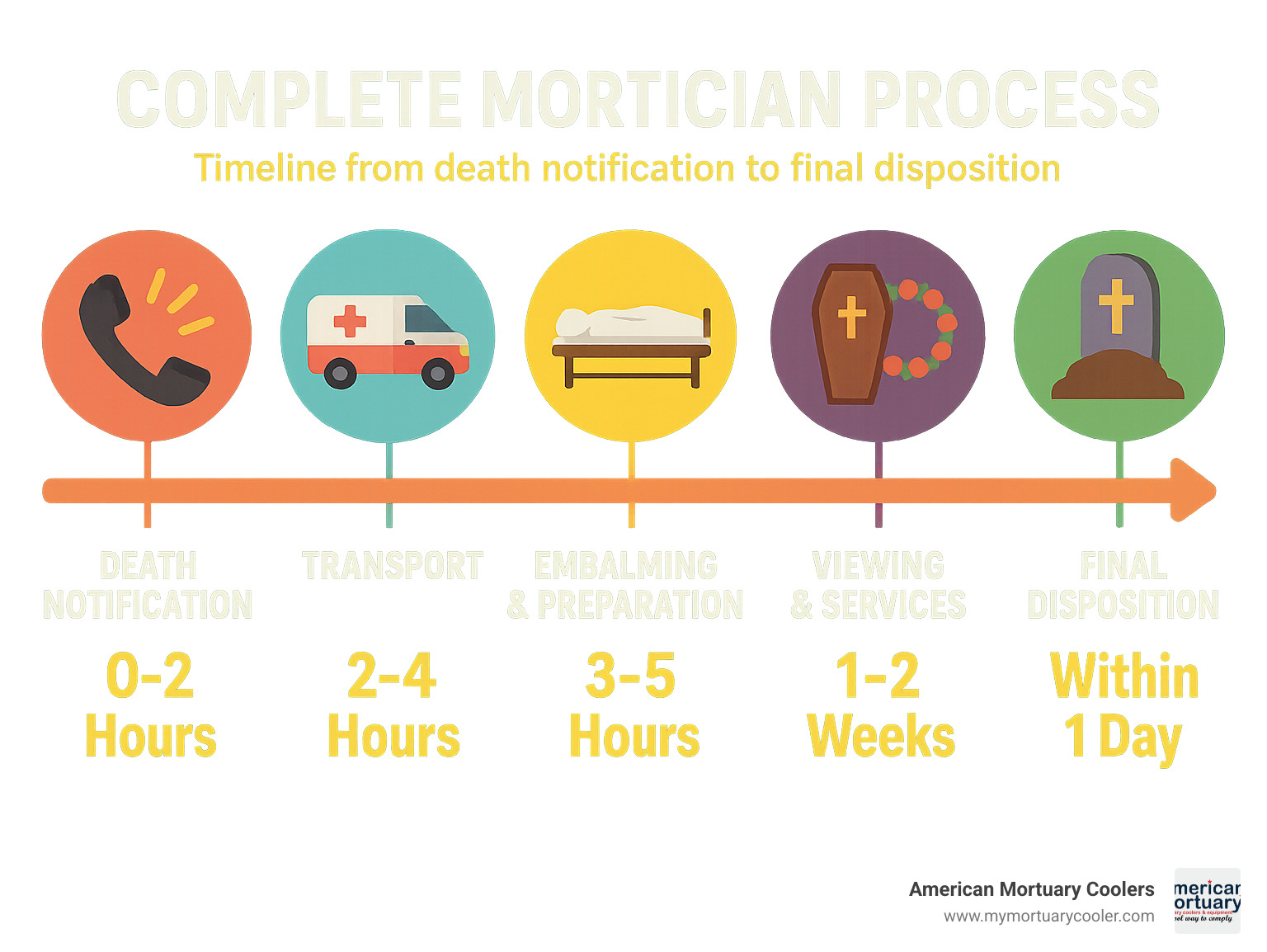
Whether families choose traditional embalming, refrigeration, or green alternatives, the mortician's goal remains unchanged: creating a peaceful, dignified presentation that helps loved ones begin their grief journey with a positive final memory.
Here at American Mortuary Coolers, we take pride in supporting funeral professionals across the United States with reliable refrigeration equipment that maintains the highest standards of care. From our Tennessee headquarters, we craft custom mortuary coolers built specifically for the unique needs of funeral homes nationwide, delivering directly to all 48 contiguous states.
For families navigating the fog of grief after losing someone dear, I hope this guide has provided some clarity about the care and respect that goes into funeral preparation. And for students considering this meaningful profession, I hope these pages have illuminated both the challenges and deep rewards of mortuary science.
The work of morticians may happen behind closed doors, but its impact ripples through communities and generations. By treating the deceased with dignity and the bereaved with warmth, morticians help us honor lives, process grief, and take those first tentative steps toward healing.
For more information about mortuary equipment and industry best practices, please visit our resource center at American Mortuary Coolers.
















